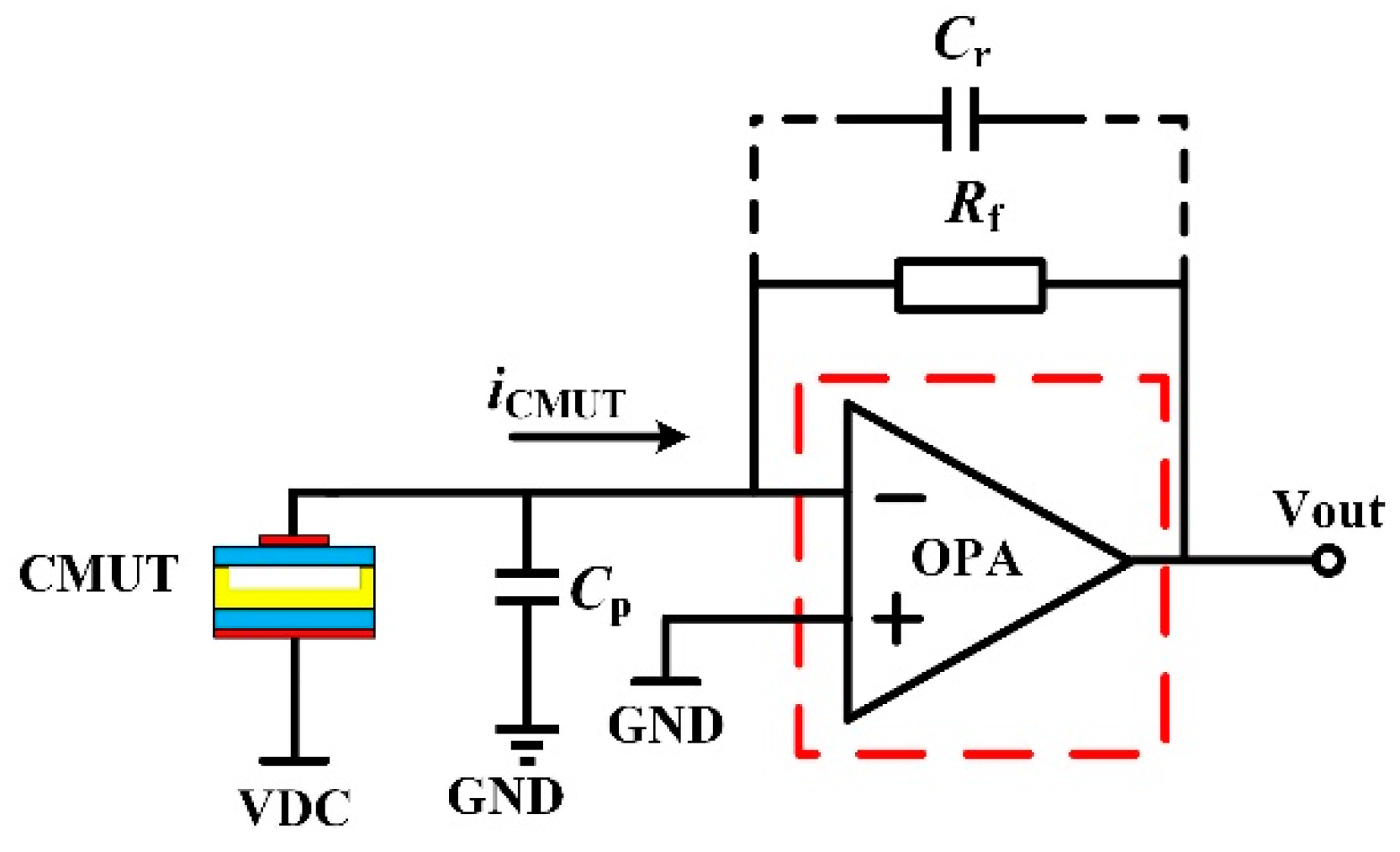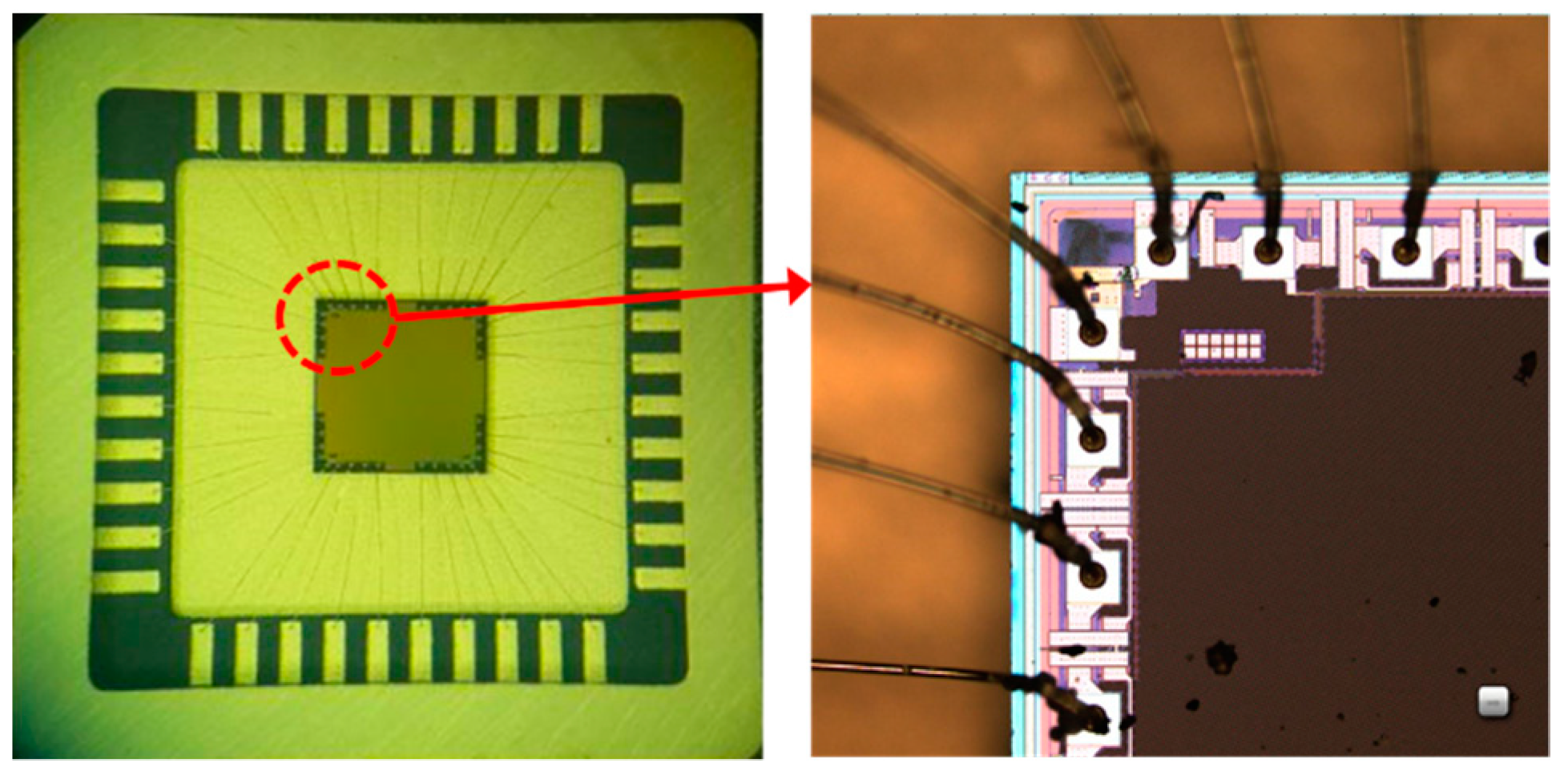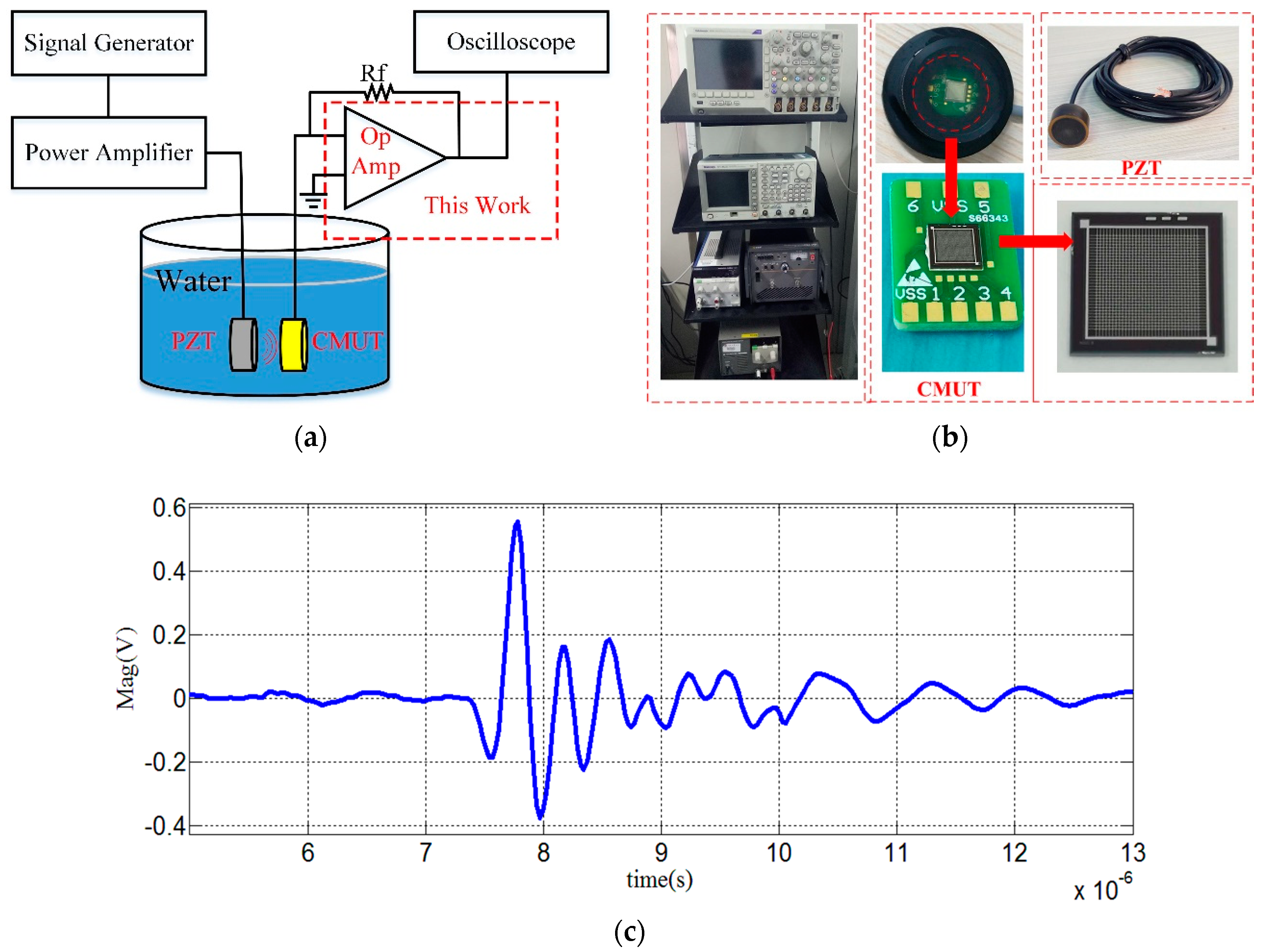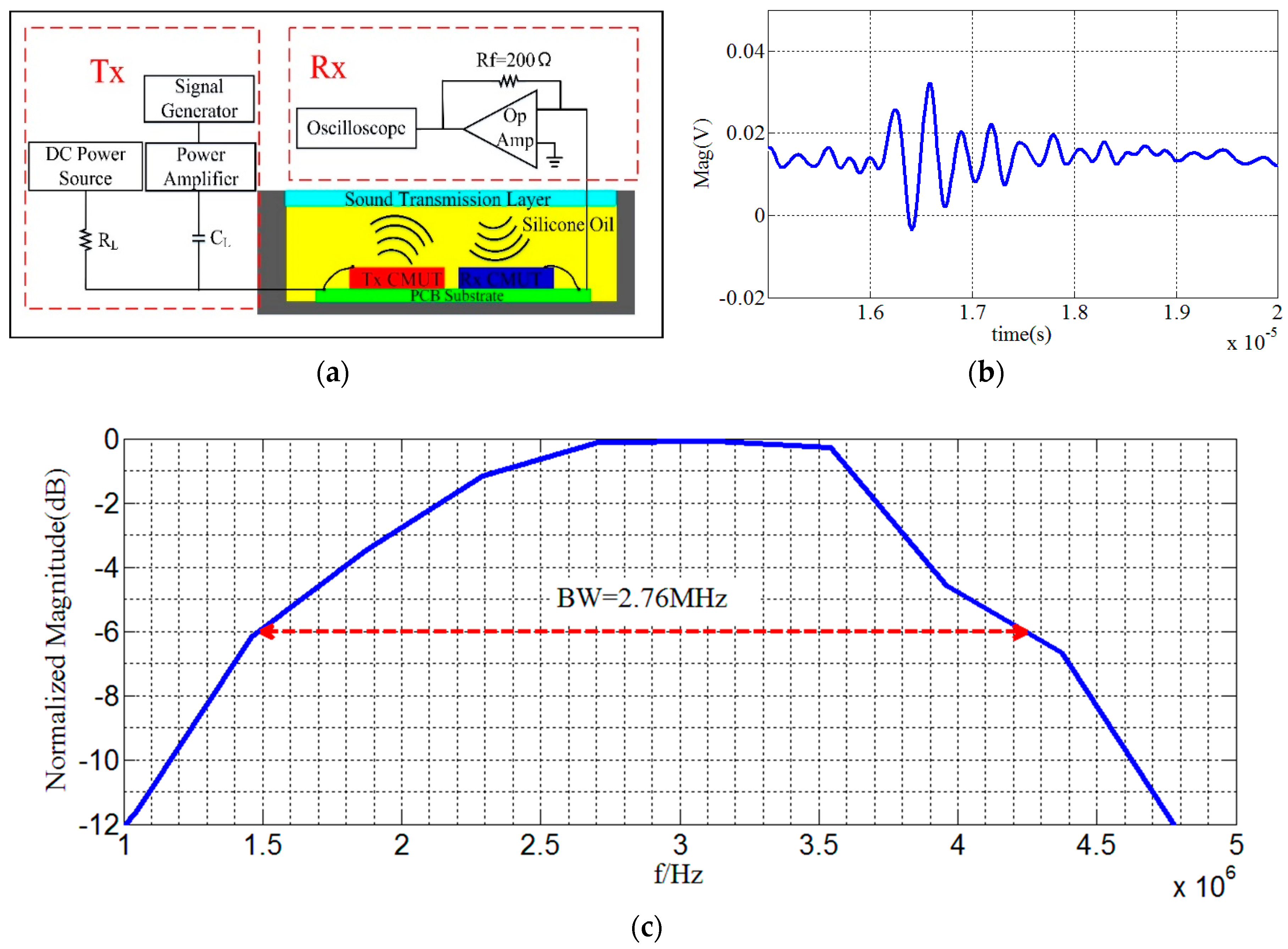Full-Differential Folded-Cascode Front-End Receiver Amplifier Integrated Circuit for Capacitive Micromachined Ultrasonic Transducers
Abstract
:1. Introduction
2. Capacitive Micromachined Ultrasonic Transducer (CMUT) Element and Equivalent Circuit Model
3. Full-Differential Operational Amplifier Design
4. Experimental Results and Discussion
5. Conclusions
Author Contributions
Funding
Conflicts of Interest
References
- Oralkan, O.; Ergun, A.S.; Johnson, J.A.; Karaman, M.; Demirci, U.; Kaviani, K.; Lee, T.H.; Khuri-Yakub, B.T. Capacitive micromachined ultrasonic transducers: Next-generation arrays for acoustic imaging? IEEE Trans. Ultrason. Ferroelectr. Freq. Control 2002, 49, 1596–1610. [Google Scholar] [CrossRef] [PubMed]
- Khuri-Yakub, B.T.; Oralkan, O. Capacitive micromachined ultrasonic transducers for medical imaging and therapy. J. Micromech. Microeng. 2011, 21, 54004–54014. [Google Scholar] [CrossRef] [PubMed]
- Salim, M.S.; Abd Malek, M.F.; Heng, R.B.W.; Juni, K.M.; Sabri, N. Capacitive micromachined ultrasonic transducers: Technology and application. J. Med. Ultrason. 2012, 20, 8–31. [Google Scholar] [CrossRef]
- Ergun, A.S.; Yaralioglu, G.G.; Khuri-Yakub, B.T. Capacitive micromachined ultrasonic transducers: Theory and technology. J. Aerosp. Eng. 2003, 16, 76–84. [Google Scholar] [CrossRef]
- Jeong, B.G.; Kim, D.K.; Hong, S.W. Performance and reliability of new CMUT design with improved efficiency. Sens. Actuat. A-Phys. 2013, 199, 325–333. [Google Scholar] [CrossRef]
- Yongli, H.; Ergun, A.S.; Haggstrom, E.; Badi, M.H.; Khuri-Yakub, B.T. Fabricating capacitive micromachined ultrasonic transducers with wafer-bonding technology. J. Microelectromech. Syst. 2003, 12, 128–137. [Google Scholar] [CrossRef]
- Yeh, D.T.; Oralkan, O.; Wygant, I.O.; O’Donnell, M.; Khuri-Yakub, B.T. 3-D ultrasound imaging using a forward-looking CMUT ring array for intravascular/intracardiac applications. IEEE Trans. Ultrason. Ferroelectr. 2006, 53, 1202–1211. [Google Scholar] [CrossRef]
- Gurun, G.; Tekes, C.; Zahorian, J.; Xu, T.; Satir, S.; Karaman, M.; Hasler, J.; Degertekin, F.L. Single-chip CMUT-on-CMOS front-end system for real-time volumetric IVUS and ICE imaging. IEEE Trans. Ultrason. Ferroelectr. 2014, 61, 239–250. [Google Scholar] [CrossRef] [PubMed]
- Iula, A.; Savoia, A.; Caliano, G. Capacitive micro-fabricated ultrasonic transducers for biometric applications. Microelectron. Eng. 2011, 88, 2278–2280. [Google Scholar] [CrossRef]
- Song, J.L.; Xue, C.Y.; He, C.D.; Zhang, R.; Mu, L.F.; Cui, J.; Miao, J.; Liu, Y.; Zhang, W.D. Capacitive micromachined ultrasonic transducers (CMUTs) for underwater imaging applications. Sensors 2015, 15, 23205–23217. [Google Scholar] [CrossRef] [PubMed]
- Noble, R.A.; Davies, R.R.; King, D.O.; Day, M.M.; Jones, A.R.D.; Mcintosh, J.S.; Hutchins, D.A.; Saul, P. Low-temperature micromachined cMUTs with fully-integrated analogue front-end electronics. In Proceedings of the IEEE Ultrasoncs Symposium, Munich, Germany, 8–11 October 2002. [Google Scholar] [CrossRef]
- Peng, S.Y.; Qureshi, M.S.; Basu, A.; Guldiken, R.O.; Degertekin, F.L.; Hasler, P.E. Floating-gate based CMUT sensing circuit using capacitive feedback charge amplifier. In Proceedings of the IEEE Ultrasoncs Symposium, Vancouver, BC, Canada, 2–6 October 2006. [Google Scholar] [CrossRef]
- Cicek, I.; Bozkurt, A.; Karaman, M. Design of a front-end integrated circuit for 3D acoustic imaging using 2D CMUT arrays. IEEE Trans. Ultrason. Ferroelectr. 2005, 52, 2235–2241. [Google Scholar] [CrossRef]
- Wygant, I.O.; Zhuang, X.; Yeh, D.T.; Oralkan, O.; Sanli Ergun, A.; Karaman, M.; Khuri-Yakub, B.T. Integration of 2D CMUT arrays with front-end electronics for volumetric ultrasound imaging. IEEE Trans. Ultrason. Ferroelectr. Freq. Control 2008, 55, 327–342. [Google Scholar] [CrossRef] [PubMed]
- Gurun, G.; Hasler, P.; Degertekin, F. Front-end receiver electronics for high-frequency monolithic CMUT-on-CMOS imaging arrays. IEEE Trans. Ultrason. Ferroelectr. Freq. Control 2011, 58, 1658–1668. [Google Scholar] [CrossRef] [PubMed]
- Nikoozadeh, A.; Wygant, I.O.; Lin, D.S.; Oralkan, O.; Ergun, A.S.; Stephens, D.N.; Thomenius, K.E.; Dentinger, A.M.; Wildes, D.; Akopyan, G.; et al. Forward-looking intracardiac ultrasoundimaging using a 1-D CMUT array integrated with custom front-end electronics. IEEE Trans. Ultrason. Ferroelectr. 2008, 55, 2651–2660. [Google Scholar] [CrossRef] [PubMed]
- Huang, X.; Cheong, J.H.; Cha, H.K.; Yu, H.; Je, M.; Yu, H. A high-frequency transimpedance amplifier for CMOS integrated 2D CMUT array towards 3D ultrasound imaging. In Proceedings of the 35th Annual International Conference of the IEEE Engineering in Medicine and Biology Society (EMBC), Osaka, Japan, 3–7 July 2013; pp. 101–104. [Google Scholar] [CrossRef]
- Sharma, S.; Ytterdal, T. Low noise front-end amplifier design for medical ultrasound imaging applications. In Proceedings of the IEEE-IFIP International Conference on VLSI and System-on-Chip, Santa Cruz, CA, USA, 7–10 October 2012; pp. 12–16. [Google Scholar] [CrossRef]
- Behnamfar, P.; Molavi, R.; Mirabbasi, S. Transceiver design for CMUT-based super-resolution ultrasound imaging. IEEE Trans. Biomed. Circ. Syst. 2016, 10, 383–393. [Google Scholar] [CrossRef] [PubMed]
- Cenkeramaddi, L.R. Feedback biasing based adjustable gain ultrasound preamplifier for CMUTs in 45 nm CMOS. In Proceedings of the International Conference on Vlsi Design and 2018 International Conference on Embedded Systems, New Delhi, India, 6–10 January 2018. [Google Scholar]
- Kumar, M.; Seok, C.; Mahmud, M.M.; Zhang, X.; Oralkan, O. A low-power integrated circuit for interfacing a capacitive micromachined ultrasonic transducer (CMUT) based resonant gas sensor. In Proceedings of the 2015 IEEE SENSORS, Busan, South Korea, 1–4 November 2015. [Google Scholar]
- Lohfink, A.; Eccardt, P.C. Linear and nonlinear equivalent circuit modeling of CMUTs. IEEE Trans. Ultrason. Ferroelectr. Freq. Control 2005, 52, 2163–2172. [Google Scholar] [CrossRef]
- Cenkeramaddi, L.R.; Bozkurt, A.; Yamaner, F.Y.; Ytterdal, T. A low noise capacitive feedback analog front-end for CMUTs in Intra Vascular ultrasound imaging. In Proceedings of the Ultrasonics Symposium, New York, NY, USA, 28–31 October 2007. [Google Scholar]
- Razavi, B. Design of Analog CMOS Integrated Circuits; McGraw-Hill: New York, NY, USA, 2001; pp. 239–257. [Google Scholar]
- Mallya, S.; Nevin, J.H. Design procedures for a fully differential folded-cascode CMOS operational amplifier. IEEE J. Solid-State Circuits 1989, 24, 1737–1740. [Google Scholar] [CrossRef]
- Daoud, H.; Salem, S.B.; Zouari, S.; Loulou, M. Folded cascode OTA design for wide band applications. In Proceedings of the International Conference on Design and Test of Integrated Systems in Nanoscale Technology, Tunis, Tunisia, 5–7 September 2006. [Google Scholar]
- Bogner, P.; Habibovic, H.; Hartig, T. A high signal swing Class AB earpiece amplifier in 65nm CMOS Technology. In Proceedings of the 32nd European Solid-State Circuits Conference, Montreux, Switzerland, 19–21 September 2006; pp. 372–375. [Google Scholar]
- Rincon-Mora, G.A.; Stair, R. A low voltage, rail-to-rail, class AB CMOS amplifier with high drive and low output impedance characteristics. IEEE Trans. Circuits Syst. II Analog Dig. Signal Process. 2001, 48, 753–761. [Google Scholar] [CrossRef]
- Lu, C.W. A Rail-To-Rail Class-AB Amplifier with an Offset Cancellation for LCD Drivers. IEEE J. Solid-State Circuits 2009, 44, 525–537. [Google Scholar] [CrossRef]
- Cheng, T.C.; Tsai, T.H. CMOS Ultrasonic Receiver with On-Chip Analog-to-Digital Front End for High-Resolution Ultrasound Imaging Systems. IEEE Sens. J. 2016, 16, 7454–7463. [Google Scholar] [CrossRef]







| Component | Value |
|---|---|
| Motional capacitor C0 (pF) | 831.88 |
| Motional inductor L0 (μH) | 1.02 |
| Motional resistor R0 (Ω) | 5.30 |
| Electrical capacitance C1 (pF) | 73.30 |
© 2019 by the authors. Licensee MDPI, Basel, Switzerland. This article is an open access article distributed under the terms and conditions of the Creative Commons Attribution (CC BY) license (http://creativecommons.org/licenses/by/4.0/).
Share and Cite
Du, Y.; He, C.; Hao, G.; Zhang, W.; Xue, C. Full-Differential Folded-Cascode Front-End Receiver Amplifier Integrated Circuit for Capacitive Micromachined Ultrasonic Transducers. Micromachines 2019, 10, 88. https://doi.org/10.3390/mi10020088
Du Y, He C, Hao G, Zhang W, Xue C. Full-Differential Folded-Cascode Front-End Receiver Amplifier Integrated Circuit for Capacitive Micromachined Ultrasonic Transducers. Micromachines. 2019; 10(2):88. https://doi.org/10.3390/mi10020088
Chicago/Turabian StyleDu, Yiheng, Changde He, Guowei Hao, Wendong Zhang, and Chenyang Xue. 2019. "Full-Differential Folded-Cascode Front-End Receiver Amplifier Integrated Circuit for Capacitive Micromachined Ultrasonic Transducers" Micromachines 10, no. 2: 88. https://doi.org/10.3390/mi10020088
APA StyleDu, Y., He, C., Hao, G., Zhang, W., & Xue, C. (2019). Full-Differential Folded-Cascode Front-End Receiver Amplifier Integrated Circuit for Capacitive Micromachined Ultrasonic Transducers. Micromachines, 10(2), 88. https://doi.org/10.3390/mi10020088






